The Silicon Valley commercial real estate market is undergoing a significant transformation. After years of pandemic-induced disruption, the region is still grappling with high vacancy rates, declining rents, and a redefinition of space utilization. As we move into 2025, these trends are expected to continue—but with new opportunities for investors, developers, and tenants alike.
2024 was a strange year for Silicon Valley’s commercial real estate scene. The tech capital of the world found itself with more empty offices than ever, and lab spaces that were booming just a couple of years ago suddenly sat quiet. But what’s really going on behind the numbers? And should we be optimistic about 2025?
A detailed breakdown is as follows, but also what it feels like on the ground.
“So Many Empty Offices” — Vacancy Rates Reach Uncomfortable Highs
You couldn’t drive through Sunnyvale or downtown San Jose without seeing a “For Lease” sign this year. According to data from JLL and the Silicon Valley Institute for Regional Studies[1], office vacancy reached 22% by the end of 2024, the highest it’s been since the mid-2000s.
Lab spaces weren’t spared either—they saw a 7x jump in vacancies from two years ago. A mix of overbuilding during the biotech boom and recent tenant downsizing left many of these spaces sitting unused.
What’s surprising? The difference between transit-accessible and non-transit office vacancy is getting smaller. In past years, being near Caltrain or BART guaranteed strong leasing activity. That’s still true, but less so than before.
| Property Type | Vacancy Rate (End of 2024) |
|---|---|
| Office | 22% |
| Lab | 26% |
| R&D | 11% |
| Industrial | 5% |
- Office Space: Over one in five square feet of office space was vacant by the end of 2024, with remote and hybrid work models significantly reducing corporate demand.
- Lab Space: Vacancies skyrocketed nearly sevenfold compared to two years ago. This is due to both overbuilding during the biotech boom and tenants downsizing.
- Transit Access Gap: Interestingly, the gap between vacancy rates for office spaces near transit vs. not near transit narrowed significantly in 2024, although offices near transit still performed better with 4% lower vacancy.
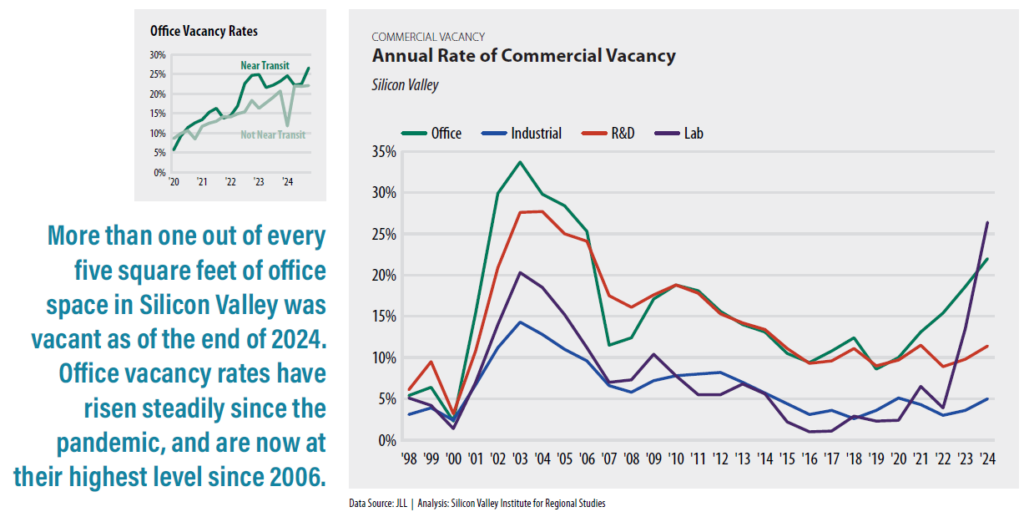
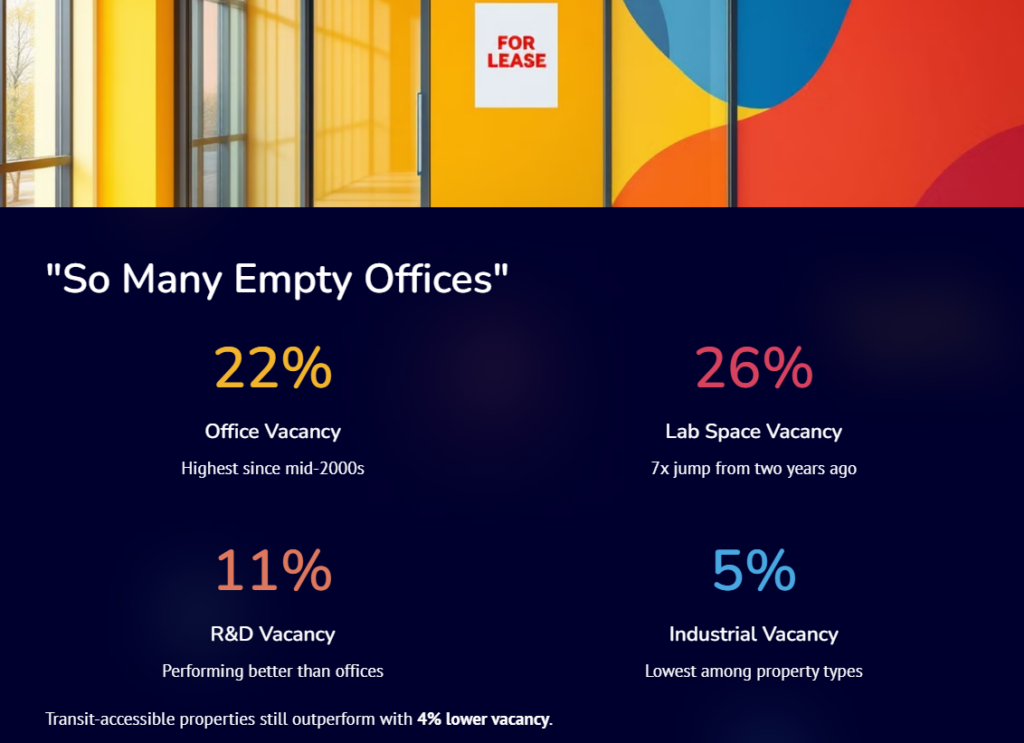
Falling Rents—But Location Still Matters
With vacancy rates that high, rents had nowhere to go but down. Across the board, commercial properties saw a dip in asking prices (inflation-adjusted):
| Property Type | Avg. Asking Rent (per sq. ft.) | YoY Change |
|---|---|---|
| Office (FSG) | $5.55 | -7% |
| Lab (NNN) | $6.44 | -5% |
| R&D (NNN) | $2.94 | -9% |
| Industrial (NNN) | $1.69 | -1% |
But Interestingly: Offices near public transit still pulled in 66% more in rent compared to those located farther from stations. So location? Definitely still king.
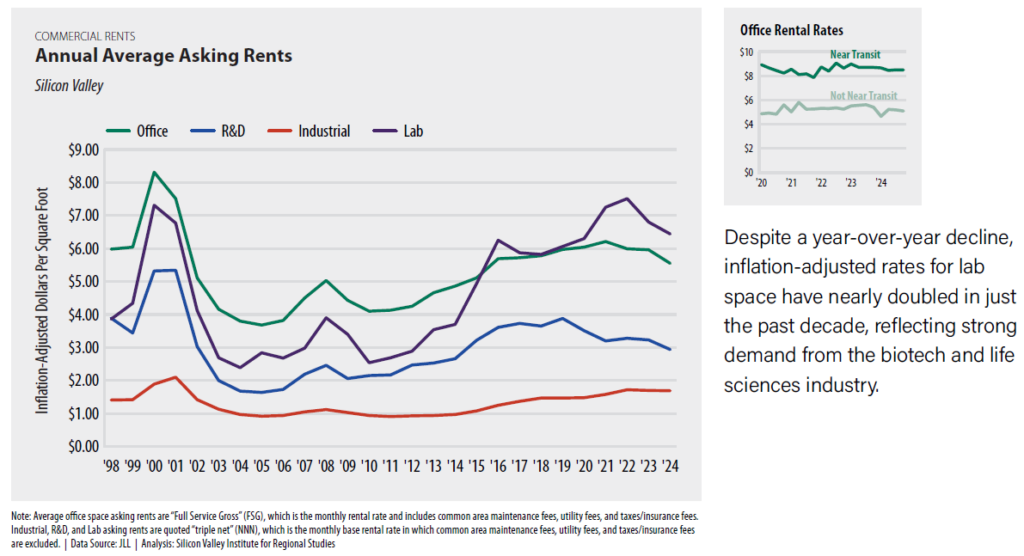
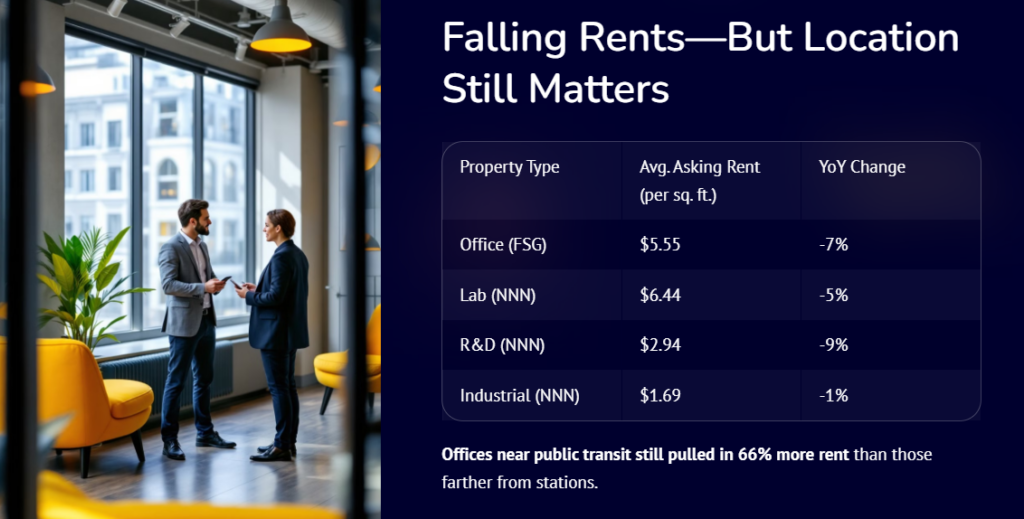
Looking Ahead to 2025: Will Things Turn Around?
Challenges remain ahead, but 2025 might offer some glimmers of hope.
🧭 The Office Market Might Level Out—But Don’t Expect a Full Comeback
Vacancy could peak in early 2025, maybe touching 23–24%, but after that, things might slowly improve. More companies are settling into hybrid routines and rethinking how much space they actually need.
Sublease inventory could shrink as some businesses choose to reoccupy rather than relocate.
🔬 Life Sciences Could Reignite Late in the Year
Lab space might see a second wind if biotech funding, which ticked up slightly at the end of 2024[2], keeps moving. Some analysts are hopeful for Q3 or Q4 2025. That could stabilize rents and trim vacancy rates back to 22–24%.
🏭 Industrial Space? Still Strong
No surprises here—e-commerce, EV manufacturing, and data centers are keeping demand high. Industrial remains the steadiest corner of the market, with vacancies likely to stay below 6%[3].

What Tenants and Investors Should Really Watch
If you’re scouting for opportunities in 2025, here’s what I’d keep an eye on:
- Proximity to transit still matters—and might matter even more if more companies start offering commute perks again.
- Adaptive reuse projects (turning old offices into labs or even apartments) could become more common, especially in dense downtown areas.
- ESG-friendly buildings and green certifications are now “must-haves” for larger tenants.
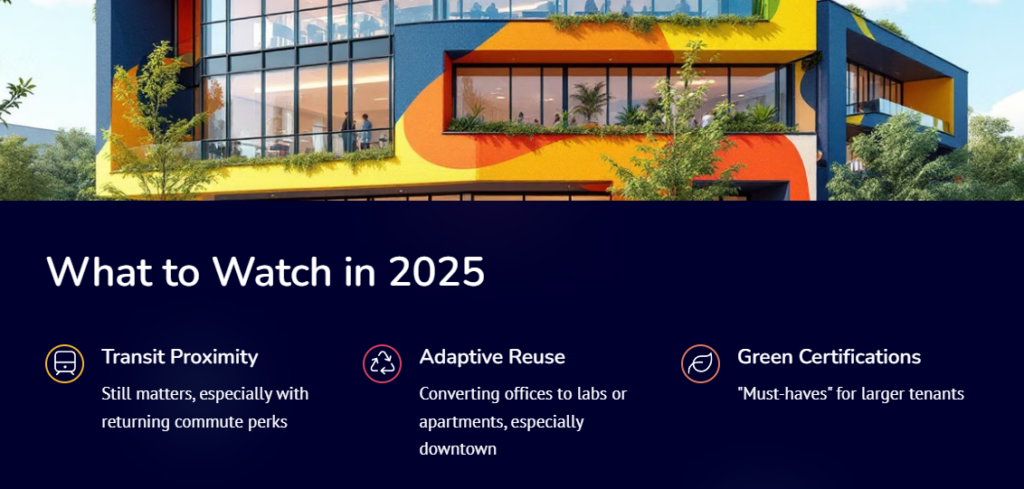
The key insight is that…
We’re clearly in a period of correction—not collapse. The commercial market is reshaping itself, not disappearing. And while it won’t be a swift rebound, those who understand these shifts early could benefit from better lease terms, investment entry points, or stronger tenant leverage.
Silicon Valley isn’t emptying out. It’s just learning to breathe a little differently.

Silicon Valley’s commercial real estate market has entered a new era—driven by flexible work, shifting tenant needs, and macroeconomic uncertainty. But with disruption comes opportunity. Stakeholders who understand the evolving dynamics and adapt early will be best positioned for success in 2025 and beyond.
Reference
- [1] Joint Venture Silicon Valley, 2025 Silicon Valley Index [PDF]
- [2] Excedr, 2025 Trends in Biotech Venture Capital Funding
- [3] Fannie Mae -Multifamily Market Commentary – January 2025 [PDF]
- [4] NAI NorCal, South Bay Market Report Q2 2024

